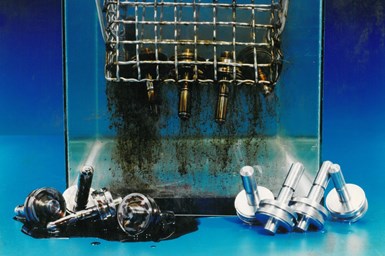Non-Hazardous Degreaser/Cleaner Safe for Most Metals and Cleaning Equipment
Unlike aqueous and many other non-hazardous cleaners, Solvent Kleene’s D-Greeze 500-LO solvent for all metals does not compromise performance for safety.

D-Greeze 500-LO's aggressive cleaning action penetrates, dissolves, and removes lubricating oils, grease, cosmolin, adhesive deposits and other contaminants. Photo Credit: Solvent Kleene
Solvent-Kleene’s D-Greeze 500-LO is a non-hazardous cleaner that cleans quickly at room temperature. According to the manufacturer, it outperforms trichloroethane. Unlike aqueous and many other non-hazardous cleaners, the solvent does not compromise performance for safety. It can be used in most existing equipment, including immersion tanks, ultrasonic systems and parts washers with little or no modification.
The solvent is suitable for use with all ferrous as well as nonferrous metals, including sensitive metals such as aluminum, titanium, brass and magnesium, and lasts 2½ times longer than a chlorinated solvent, the company says.
D-Greeze 500-LO’s aggressive cleaning action penetrates, dissolves and removes lubricating oils, grease, cosmolin, adhesive deposits and other contaminants. With its low surface tension, low viscosity and said to be superior cleaning properties, the cleaning fluid is said to quickly penetrate and clean small orifice openings, blind holes and other difficult-to-clean surfaces.
Because it is designed to dissolve, emulsify and remove oils and greases without allowing the oils to surface when parts are removed from a tank they are not recontaminated.
Best degreasing cleaning results are achieved by total immersion and agitation. Because D-Greeze 500-LO cavitates very well, it is suitable for use in ultrasonic equipment without the use of heat. For quick drying requirements, the cleaner can be mechanically dried in seconds by air blow-off, leaving parts dry, spotlessly clean and residue free. The drying should take place in an enclosed, ventilated chamber and the stripped-off liquid collected for reuse.
Related Content
-
What is Scientific Maintenance? Part 2
Part two of this three-part series explains specific data that toolrooms must collect, analyze and use to truly advance to a scientific maintenance culture where you can measure real data and drive decisions.
-
What You Need to Know About Hot Runner Systems and How to Optimize Their Performance
How to make the most out of the hot runner design, function and performance.
-
Think Safety: Eliminate Hazards Throughout the Shop
The tooling community is taking advantage of new products for safer mold shops and molding facilities.














